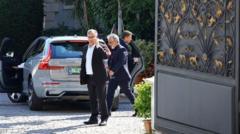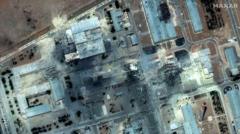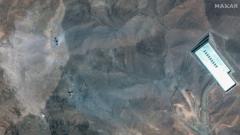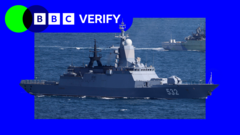Recent satellite analysis has unveiled significant damage to key Iranian nuclear facilities and military sites, raising concerns among international observers about the escalating conflict.
**Escalation in the Middle East: Satellite Images Reveal Damage to Iranian Nuclear and Missile Sites**
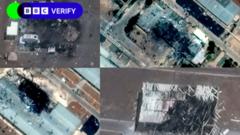
**Escalation in the Middle East: Satellite Images Reveal Damage to Iranian Nuclear and Missile Sites**
Satellite imagery sheds new light on the destruction of Iranian military installations amid ongoing tensions.
In a striking development in the Middle East, recent satellite imagery has illuminated the extensive damage inflicted on crucial Iranian military installations and nuclear sites. The analysis, released by Maxar and shared with BBC Verify, documents the results of recent strikes that have intensified regional tensions.
The comprehensive images highlight severe damage at critical locations including the Natanz nuclear facility and a missile site south of Tabriz. This comes in the wake of an aggressive military operation led by Israel, which has targeted a variety of Iranian sites since last Friday, prompting retaliatory responses from Iran.
Maxar's optical imagery showcases the aftermath of the strikes, particularly at Natanz, a facility known for its uranium enrichment activities. The International Atomic Energy Agency (IAEA) confirmed that the above-ground section of the pilot fuel enrichment plant has been destroyed. This site is essential for Iran's nuclear ambitions, as it is capable of producing uranium enriched up to 60% U-235—both for power generation and potential weaponization. Rafael Grossi, the IAEA director, reported that no increase in off-site radiation has been detected, indicating that while damage has been significant, the risk of nuclear fallout remains contained.
Analysis by experts, including Justin Bronk from the Royal United Services Institute, suggests that specialized "bunker buster" munitions were likely employed in the strikes, though there has been no confirmation of damage to the underground enrichment facilities essential to uranium processing. Additional damage was reported at the Isfahan site, where critical buildings like the uranium conversion facility were impacted—as shown by photographs documenting visible damage from multiple angles.
Beyond nuclear facilities, satellite imagery from Umbra Space has exposed targeted strikes on various missile complexes. Notably, areas in and around Tabriz have seen damage to weapon storage facilities and missile silos. Moreover, low-resolution images reveal extensive fire damage near missile bases in Kermanshah, underscoring the potential scale and intensity of recent military actions. Footage corroborated by various sources showed substantial smoke plumes rising from multiple locations, indicating ongoing operations.
Interestingly, other key sites like the Arak heavy water reactor and Fordow enrichment facility did not exhibit signs of damage, despite earlier reports suggesting otherwise. This inconsistency has led to speculations about the strategic objectives of the strikes and their implications for regional stability.
As this situation unfolds, the global community watches with concern, understanding that the balance of power in a region fraught with tension could shift dramatically in the coming days due to these military developments. The ramifications of such military engagements continue to reverberate, heightening fears of an all-out conflict.
The current state of affairs highlights the pressing need for diplomatic dialogue to defuse tensions, albeit the latest reports illustrate the dangers posed by escalated military interventions in an already volatile region.
The comprehensive images highlight severe damage at critical locations including the Natanz nuclear facility and a missile site south of Tabriz. This comes in the wake of an aggressive military operation led by Israel, which has targeted a variety of Iranian sites since last Friday, prompting retaliatory responses from Iran.
Maxar's optical imagery showcases the aftermath of the strikes, particularly at Natanz, a facility known for its uranium enrichment activities. The International Atomic Energy Agency (IAEA) confirmed that the above-ground section of the pilot fuel enrichment plant has been destroyed. This site is essential for Iran's nuclear ambitions, as it is capable of producing uranium enriched up to 60% U-235—both for power generation and potential weaponization. Rafael Grossi, the IAEA director, reported that no increase in off-site radiation has been detected, indicating that while damage has been significant, the risk of nuclear fallout remains contained.
Analysis by experts, including Justin Bronk from the Royal United Services Institute, suggests that specialized "bunker buster" munitions were likely employed in the strikes, though there has been no confirmation of damage to the underground enrichment facilities essential to uranium processing. Additional damage was reported at the Isfahan site, where critical buildings like the uranium conversion facility were impacted—as shown by photographs documenting visible damage from multiple angles.
Beyond nuclear facilities, satellite imagery from Umbra Space has exposed targeted strikes on various missile complexes. Notably, areas in and around Tabriz have seen damage to weapon storage facilities and missile silos. Moreover, low-resolution images reveal extensive fire damage near missile bases in Kermanshah, underscoring the potential scale and intensity of recent military actions. Footage corroborated by various sources showed substantial smoke plumes rising from multiple locations, indicating ongoing operations.
Interestingly, other key sites like the Arak heavy water reactor and Fordow enrichment facility did not exhibit signs of damage, despite earlier reports suggesting otherwise. This inconsistency has led to speculations about the strategic objectives of the strikes and their implications for regional stability.
As this situation unfolds, the global community watches with concern, understanding that the balance of power in a region fraught with tension could shift dramatically in the coming days due to these military developments. The ramifications of such military engagements continue to reverberate, heightening fears of an all-out conflict.
The current state of affairs highlights the pressing need for diplomatic dialogue to defuse tensions, albeit the latest reports illustrate the dangers posed by escalated military interventions in an already volatile region.

